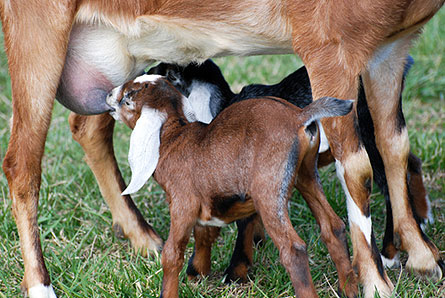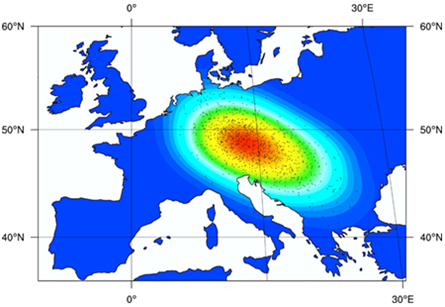Got milk? How?
Scientists are tracking down the first people who squeezed this nutritious liquid out of animals thousands of years ago
By Emily Sohn
We put it in cereal. We drink it with cookies. And we eat tons of foods that are made from it, including yogurt, cheese and even some crackers, breads and granola bars. For most of us, milk is a staple that would be hard to live without.
Thousands of years ago, though, only babies drank milk — and that milk came from their mothers. Now, scientists are investigating the beginnings of mankind’s long-lasting love for daily products. They are looking back thousands of years, to the days when people first squeezed milk out of cows and other animals for use as food and drink.
Tracking down the first milk drinkers could give insight into some bigger questions. For example, why do so many people today still get sick from drinking milk? In some countries, almost nobody can digest dairy products.
The work could also help explain major events in human history. Before refrigerators and grocery stores kept a steady supply of fresh food around, dairying probably transformed societies.
“If you can have an animal supply nutrition without killing it, that’s a real step in agriculture,” says Richard Evershed, a chemist at the University of Bristol in the United Kingdom. “That’s spectacular in terms of human nutrition.”
As easy as milk is to find these days, though, its history is challenging to piece together. Like detectives, researchers are tackling the milk mystery in more ways than one.
They are analyzing ancient milk scum on extremely old pots. They’re tracking down the genes that allowed people to digest milk, which is surprisingly hard for many people to stomach. They’re even looking for clues in the buried bones of cows, sheep, horses and other milk-making animals.
“Milk was probably the world’s first superfood,” says Mark Thomas, a scientist at University College London who studies how genes have changed throughout history. The advantages of being able to drink it, he adds, “are just out of this world.”
Thanks, moms
To most people, milk comes in a carton. But milk originally comes from the bodies of mammals. Human as well as other mammal mothers, including dogs, cats, pigs and mice, produce milk to feed their babies.
 |
|
Mammal babies, including goats, get milk from their mothers. Human mothers also provide milk to their very young children, but most people get milk from the store.
|
| isaact/iStockphoto |
Most of the milk in U.S. grocery stores comes from cows. In other countries, it is common to drink the milk of sheep, goats, camels, even horses. Each type of milk has a different flavor. Some types are easier to stomach than others.
Evershed recently sampled milk from horses in Kazakhstan. “It was the most disgusting drink I’ve ever tasted,” he says. “I just didn’t like it.”
Unlike meat, milk does not require that an animal be slaughtered. But the first dairy farmers had to figure out for themselves how to turn wild animals into ones that could be raised in captivity. Then, they needed to herd the animals, care for them and continue to milk them even after the animals’ babies grew up.
Another complication: Milk drinking doesn’t come naturally to older kids and adults. Milk contains a type of sugar called lactose. In order to turn lactose into energy, our bodies need an enzyme called lactase. Enzymes are proteins that help the body do its work.
Like other newborn mammals, baby humans have plenty of lactase, which allows them to gulp down their mothers’ milk. After age 2 or so, though, lactase levels drop.
Without lactase, people can get very sick from dairy products. Symptoms include gas, stomach cramps and severe diarrhea. The condition is called lactose intolerance.
None of our early ancestors could digest milk as adults because their bodies never had to — milk drinking simply wasn’t an option. As people began to extract milk from animals, though, some people developed the ability to keep drinking it throughout their lives.
That biological switch proved to be a huge boost toward survival. Milk is full of calories, fat, protein, calcium and other nutrients. For ancient man, it would have been a valuable and steady source of food.
Scientists now know of a milk-related mutation in our genes — the chemical instructions for life that we carry in almost every cell in our bodies. People who have a mutated form of one particular gene can drink milk just fine. People without the mutation tend to get sick from milk.
“The ability to digest milk, Thomas says, “has been incredibly important for people’s survival for the last 8,000 to 10,000 years. We still just don’t know why.”
The first milk drinkers
To figure out where, and possibly why, milk drinking started, some scientists have been looking at who has the milk-digesting mutation today. Patterns are striking.
Most adults in Northern and Central Europe are able to digest milk — and they do. Cheese, butter and other dairy products are popular in countries such as Sweden, Denmark, Germany and England. Because European settlers dominated North America, most people here can handle milk just fine, as well. That may explain why ice cream is such a popular dessert in the United States.
In much of Africa, Asia and South America, on the other hand, people tend to avoid dairy products because they lead to diarrhea and other stomach problems. (That’s why you won’t typically find cheese on the menu at a Chinese, Japanese or Ethiopian restaurant.) Native Americans are also unable to digest lactose.
Based on these genetic patterns, scientists have long thought that milk drinking started in Northern Europe, where dairy is an institution and the milk-digesting mutation is everywhere.
 |
|
The different circles of color on this map of Europe show where lactose tolerance—the ability for older children and adults to drink milk without it causing illness or discomfort—developed in a particular area. |
| Yuval Itan, Adam Powell, Mark G. Thomas |
A recent study painted a different picture. With a computer model, Thomas and colleagues looked at the spread of the milk-drinking mutation, farming and other related factors. Working backward, the scientists concluded that the first milk-drinkers lived in Central Europe around what’s now Hungary about 7,500 years ago. The practice didn’t start farther north, as scientists had thought before.
Around that time, a farming culture called the Linearbandkeramik also sprouted in the area that’s now Hungary. The culture spread quickly over the next few hundred years into most of northwestern Europe.
Milk drinking, Thomas says, was probably responsible for the success of the Linearbandkeramik. And milk-drinking Linearbandkeramik may have transformed Europe.
“They probably shaped the language and cultural map of Northern Europe over the last several thousand years,” Thomas says. “We now think the ability to digest milk was crucial to [their] spread.”
Dairy before milk
The story doesn’t start or end there. It’s now clear that people ate dairy foods before they actually drank milk.
Over the last decade, Evershed has analyzed pottery remains from many hundreds of ancient vessels at dozens of sites in Europe.
His group has also identified dried-up milk fat on the oldest pottery shards ever found, dating back 9,000 years from an area outside Europe, in the Middle East, called the Fertile Crescent. The region now includes Iraq, Syria and Israel. It’s probably where people first domesticated animals.
In fact, milking may have started even earlier than that. Although archaeologists haven’t found older pottery remains, scientists do have evidence that early sheep herds were mostly female. That might mean that the herd was used for milk, rather than meat. It’s the females, after all, that produce milk.
Despite those clues, Thomas — who has pulled genetic material out of the bones of early European farmers — has found no sign that people had the gene mutation for digesting lactose before 7,500 years ago.
So, why were people milking animals if they couldn’t digest the milk?
It turns out that fermenting and processing milk into yogurt, cheese and other products removes much of the lactose. Even people who are lactose-intolerant can often eat these foods without getting sick.
Dairy foods last longer than milk without spoiling. And fermenting, for instance, is not hard to do: In a hot country, people would have just needed to leave milk in a pot outside for most of the day to turn the milk into a nutritious, digestible yogurt.
“We are now pretty convinced,” Thomas says, “that the ability to digest milk came after the skills necessary to produce it.”
From when and where, to why?
Now that scientists know more about when and where milking started, they are struggling to explain why people started drinking milk in the first place.
Among a variety of theories about milk, Thomas likes the idea that animals provide a steady supply of it. Crops boom and then bust. Meat comes with finality: the end of an animal’s life. But on the other hand, as long as you keep feeding and milking a cow, her milk keeps coming.
There would have been other advantages, too. Milk is cheap. It’s nutritious. And it harbors fewer dangerous bacteria compared with liquids like river water, which could have made people terribly sick.
Investigating milk, scientists say, is a great way to help people connect with their food and where it comes from. In a recent presentation for schoolkids, Evershed included a poster of someone squeezing milk from the udders of a cow into a pot.
“It was a lovely picture,” Evershed says, and the image was symbolic, too. “It brought home man’s intimate relationship with animals and the way we live with them and rely on them. The supermarket makes you forget that.”







